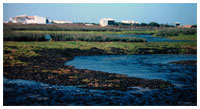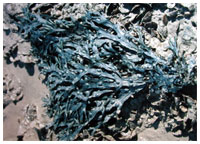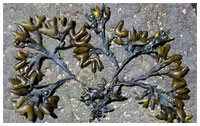home > research > circadian and circatidal cycles and signals for the chloroplast: photosynthetic physiology and gene expression responses in Fucus
Circadian and circatidal cycles and signals for the chloroplast: photosynthetic physiology and gene expression responses in Fucus
 Recent investigations of gene expression by our team, have shown that chloroplast-encoded ribulose-1,5-bisphosphate carboxylase (rbcL, rbcS), ATP synthase (atpH, atpI), and photosystem I chl a binding protein (psaA) mRNA abundances vary in response to irradiance and immersion/emersion in Fucus vesiculosus. We now aim to evaluate whether the variability in photosynthetic parameters and gene expression in Fucus vesiculosus, detected in our previous studies, is related to circadian and/or circatidal signals and/or endogenous rhythms. The work involves determining gene sequences from macroalgal chloroplasts (plastids) to study their regulation and control of expression in photosynthetic organisms living in intertidal environments.
Recent investigations of gene expression by our team, have shown that chloroplast-encoded ribulose-1,5-bisphosphate carboxylase (rbcL, rbcS), ATP synthase (atpH, atpI), and photosystem I chl a binding protein (psaA) mRNA abundances vary in response to irradiance and immersion/emersion in Fucus vesiculosus. We now aim to evaluate whether the variability in photosynthetic parameters and gene expression in Fucus vesiculosus, detected in our previous studies, is related to circadian and/or circatidal signals and/or endogenous rhythms. The work involves determining gene sequences from macroalgal chloroplasts (plastids) to study their regulation and control of expression in photosynthetic organisms living in intertidal environments.  Patterns of chloroplast-encoded gene transcription and adundance in intertidal fucoid algae in relation to circadian and tidal rhythms will be revealed for the first time and environmental and/or endogenous cues with a role in regulating chloroplast mRNA abundance will be identified.
Patterns of chloroplast-encoded gene transcription and adundance in intertidal fucoid algae in relation to circadian and tidal rhythms will be revealed for the first time and environmental and/or endogenous cues with a role in regulating chloroplast mRNA abundance will be identified.
Clockwise from top: Fucus vesiculosus, Ria Formosa (photo by G Pearson); Fucus vesiculosus, Tejo (photo by Soraia Santos); Fucus vesiculosus, Lima river (photo by Carla Monteiro)


